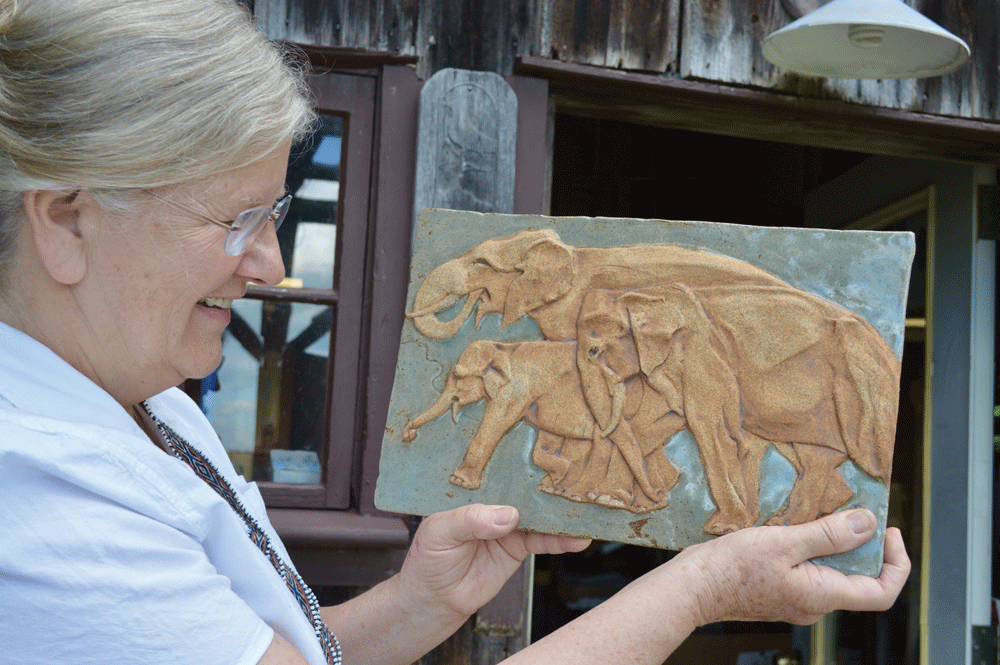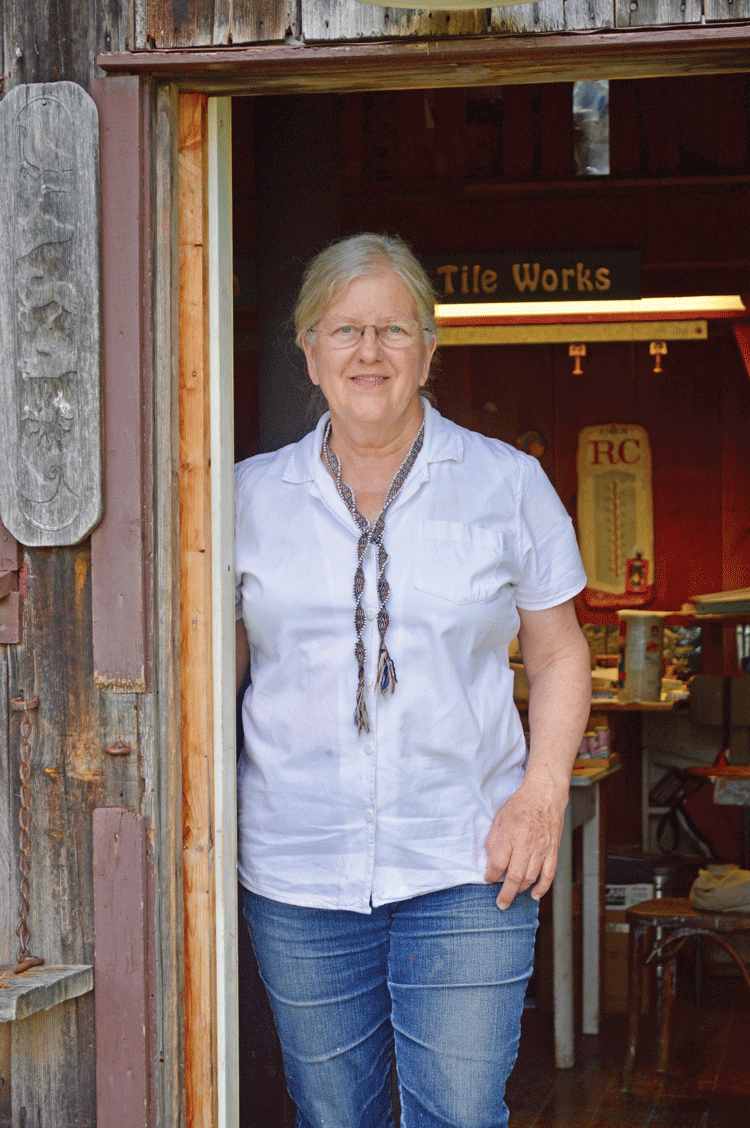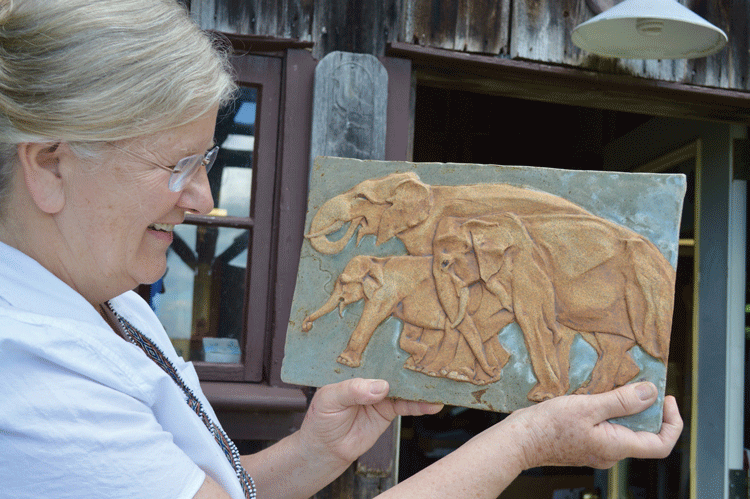Joan Gardiner: Renaissance Woman

Photos and story by Kerry Phelps Dale
It all started with a leaky roof, a valuable painting and a New Yorker short story.

Joan Gardiner, a potter, and her husband, John, a novelist and short story writer, lived in their humble cottage with a leaky roof in historic Unison, Virginia. On the 18th century plaster walls of their living room hung a painting handed down to John from his New England family. The couple knew nothing of the painting until a visiting friend recognized the artist, Frances Augustus Silva, from a recent exhibit at the Smithsonian National Gallery of Art.
The Gardiners decided to sell their surprisingly valuable painting hoping it might bring enough money to fix the roof. When they turned the painting over to a fine art auction house, they were delighted to learn that its value far exceeded their expectations.
The real-life story was creative nectar for John Gardiner who wrote a fictional piece for the New Yorker, one of the most prestigious of literary magazines. The wife in the story, “American Light,” was an artist who made porcelain relief tiles.
“I really identified with her,” said Gardiner. So much so that the potter felt it was a foretelling of her intended career. Ever since, she has eschewed the wheel for the worktable in the creation of ceramic painted and relief tiles.
The Edward Lear (best known for The Owl and The Pussy Cat) inspired alphabet tile border adorning her home’s kitchen was her first project in what developed into both a passion and profession. Ceramic tiles proved to be the ideal medium to highlight Gardiner’s art education, gift of storytelling and playful wit.
Gardiner is first an artist: a painter and a sculptor. Educated at the Maryland Institute in Baltimore, she realized early on that functional art appealed more to her sensibilities than paintings and sculptures. The seemingly pointless pattering about what a painting meant or what an artist was trying to express and the endless critiquing of artistic expression did not suit Gardiner.
She found herself drawn to the potter’s wheel, the kiln and the creation of functional art. To make her point, if only to herself, she once produced a painting that she transformed into the front doors of a small cabinet. “I was only comfortable if something also had a function,” said Gardiner.
When she transitioned from fine art to pottery, she found her art home among the clay artists. “They are more inclusive and share more. It’s not a competitive group,” said Gardiner. And she didn’t have to explain her work.
The body of work Gardiner is most known for are her tiles made from red and white clay.
In the hand-making of these tiles, Gardiner has created the very canvas for both painting and sculpting. Even her simple unadorned tiles, are works of art with their rich glazes and undulating surfaces.
If Gardiner is first an artist, she is second a storyteller. It is her sense of humor and keen awareness of how history informs the present and future that most influence much of her noncommission work.
Her creative and intelligent interpretation of time and place have garnered her mural contracts for nearly every public library in Loudoun County. Her affinity for the accurate and artistic depiction of nature’s plant and animal bounty have put her tiles in the kitchens and bathrooms of some of the area’s finest homes.
The Rust Library in Leesburg, Virginia, is home to what Gardiner says is probably her favorite of her large works. Her vision led to multiple murals throughout the library acknowledging the generous benefactor, A.V. Symington, and celebrating the events of the philanthropist’s lifetime. An assemblage of Gardiner’s work is installed throughout the library, including individual tiles and smaller murals, a veritable gallery of the dynamic range of the functional work of a true artist.
Currently in the throes of the Sterling library commission, Gardiner’s worktable is covered with an oversized tile of a 1960s pickup truck. The “Journeys to Sterling” mural will depict the migration to the immigrant rich community of Sterling, Virginia, through tiles rendered from photos of actual residents, images of communities of their origination and sculpted modes of transportation.
Though most of Gardiner’s jobs are commissioned and installed in homes and libraries throughout the area, a walk around her 4-room studio/workshop is a mesmerizing tour of the scope and longevity of Gardiner’s career through individual tiles, small framed murals and pottery.
There are exquisite reliefs of birds and insects, foxes and rabbits, elephants and alligators. There are blue and full color delft painted tiles. Charmingly original and detailed works of the natural world sit on shelves and hang on walls and hundreds of molds are stacked on shelves and sit in boxes.
Comingled with her more serious pieces are splashes of Gardiner’s wit and humor, sometimes arresting and usually, more than meets the eye. There’s a shark on a stick which, while compelling on its own, was created solely to help market mugs celebrating televisions cultish midsummer Shark Week. A framed tile features a wasp relief encroaching the face in a black and white silkscreened photograph of the fearful and wild-eyed George Ohr, “self-proclaimed greatest potter in the world,” said Gardiner. “You have to love anyone self-proclaimed.”
One wall of the studio is nearly covered, mosaic-style, with bits and pieces of Gardiner’s more light-hearted works.
And then there’s Gardiner’s Shrine of Weird displayed on a wall near the back of her studio. The collage of items, reminiscent of the advertisements from the back pages of comic books, is a nod to inspiration from unexpected sources.
Within the yellowing cellophane packaging of the “Fly Powered Airplane,” are simply two toothpicks and two rolling papers. Fly not included.
Gardiner, intrigued by the item, investigated the “inventor.” She learned that when he watched his “Fly Powered Airplane” fly for the first time, he is said to have remarked, “Now I know how the Wright Brothers felt.”
Her walk away from the serious art world provided Gardiner the opportunity to produce seriously magical works of art that anyone and everyone can relate to. Much of the ceramist’s work appeals to children such as murals in the children’s sections of libraries, tiles, collages and tea sets inspired by nursery rhymes, Alice in Wonderland, Aesop’s Fables and other children’s literature. Gardiner finds children entertaining and inspirational and she has devoted much of her work and time to honoring children and childhood within her studio and beyond.

In addition to taking neighbor children into her studio, divining and nurturing their artistic expression, Gardiner devotes much of her free time to mentoring individual children. She has volunteered for 20 years for Team and Teen Saturday, a program of recommended students from other schools which convenes biweekly during the school year at The Hill School in Middleburg.
Gardiner oversees the art projects that the children work on throughout the year until Christmas break. After the holidays the children begin designing and making kites for the annual Blossom Kite Festival in Washington, DC.
Since 2013, Gardiner’s students have dominated the competition, children travel from all over the country to compete in areas of artistic and aeronautic design and a test of the kite and inventor’s flying ability. “We win every year,” said Gardiner proudly.
Having taken the top three places for the past four years, the Teen Saturday group has become the people to beat, a great source of pride for all involved.
“People are so nice to the kids and they get a lot of attention from, the radio and TV stations,” said Gardiner. “The children are very serious about the completion.”
The experience of making the kites together allows the children to help each other in ways that shift the normal social power structure. Children born in the U.S. don’t have the hands-on skills, such as tying knots or weaving that children from different cultures may have. For one child to teach another to tie a knot can be a seed of empowerment. “God Bless the child who’s got his own,” Gardiner quoted from the Billy Holiday song, then mused, “Saving the world in flying kites.”
If Gardiner can’t be tracked down at her studio, an installation or at The Hill School, she most likely can be found with her bees, one more thing Gardiner does with passion. Somehow, she finds time to manage approximately 30 hives, mentor new beekeepers and bottle 650 lbs. of honey.
“Beekeeping is addictive,” said Gardiner. “If you can keep them from dying, you learn so much by observing them. Bees are a super organism that collectively is like a dog. They recognize you, know how you move and what you smell like.”
Working with bees can be frustrating and discouraging owing to the mysterious plight of the honeybee, but Gardiner is captivated and finds beekeeping an endless journey in discovery. “You can’t become an expert, because there is so much to learn.”
It’s well-known that artists and deadlines often don’t mix well, and though Gardiner regularly meets her deadlines, sometimes she needs a little push. “Guilt is one of my biggest motivators,” said Gardiner.
Just once the emotions of anxiety and guilt came to her externally, from the client, and the normally agreeable artist took it to him Gardiner-style. “I added a $50 hassle fee to his bill,” she recalled. “When he asked what that was for, I told him, ‘You really stressed me out and made me nervous.’”
Gardiner’s rare venture into uncomfortable confrontation ended well, though. “He felt bad and apologized.”
Gardiner hasn’t lost any passion for tile making and her ever-curious mind continues to inform her art. From moving to the Loudoun countryside in 1973 so she could affordably live and board her horse, to marrying John and raising her daughter Nicola, to her career as an artist and a manager of the costume shop for Julliard School in New York City, to mentoring children, to helping to preserve the at-risk bee population, Gardiner has crafted her life as artfully and thoughtfully as she crafts her treasured tiles. ML


